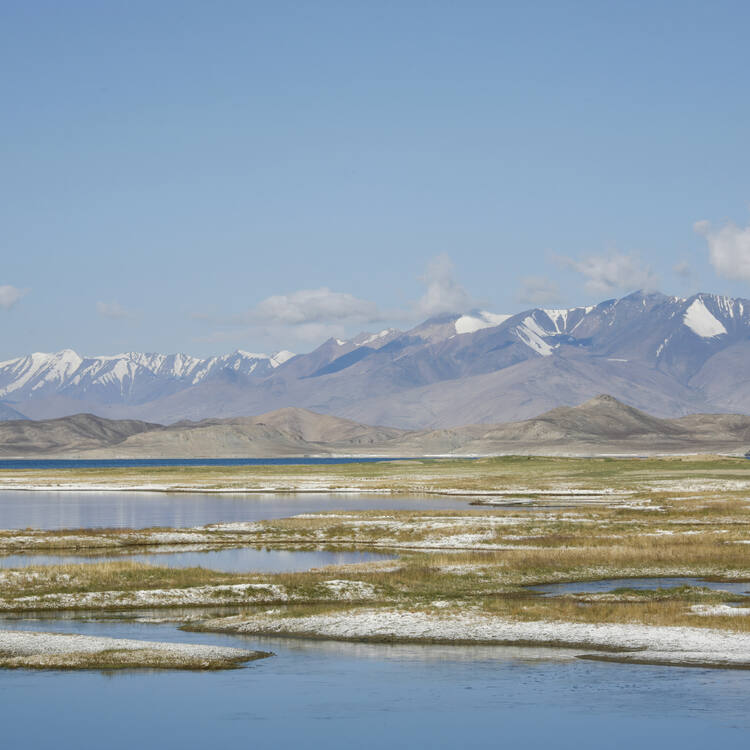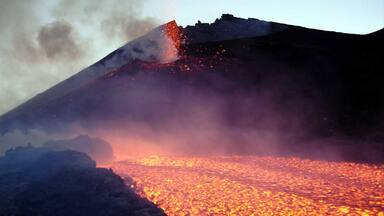Tajik National Park (Mountains of the Pamirs)
Tajik National Park (Mountains of the Pamirs)
Tajikistan National Park covers more than 2.5 million hectares in the east of the country, at the centre of the so-called “Pamir Knot”, a meeting point of the highest mountain ranges on the Eurasian continent. It consists of high plateaux in the east and, to the west, rugged peaks, some of them over 7,000 meters high, and features extreme seasonal variations of temperature. The longest valley glacier outside the Polar region is located among the 1,085 glaciers inventoried in the site, which also numbers 170 rivers and more than 400 lakes. Rich flora species of both the south-western and central Asian floristic regions grow in the Park which shelters nationally rare and threatened birds and mammals (Marco Polo Argali sheep, Snow Leopards and Siberian Ibex and more). Subject to frequent strong earthquakes, the Park is sparsely inhabited, and virtually unaffected by agriculture and permanent human settlements. It offers a unique opportunity for the study of plate tectonics and subduction phenomena.
Description is available under license CC-BY-SA IGO 3.0
Parc national tadjik (montagnes du Pamir)
Situé à l’est du Tadjikistan, au cœur du « nœud du Pamir » (carrefour des plus hautes chaînes montagneuses de l’Eurasie), le site couvre plus de 2,5 millions d’hectares accidentés et très peu peuplés. A l’est, il s’agit de hauts plateaux et, à l’ouest, de pics dont certains dépassent les 7 000 mètres d’altitude. Les variations saisonnières de température sont extrêmes. Le Fedtchenko – le plus long glacier de vallée en dehors des régions polaires - est un des 1085 glaciers dénombrés sur ce site qui compte 170 cours d’eau et plus de 400 lacs. Deux groupes d’espèces florales (celui d’Asie centrale et celui d’Asie du sud-ouest) poussent sur le site qui héberge aussi des espèces rares et menacées d’oiseaux et de mammifères (notamment l’argali de Marco Polo, le léopard des neiges, l’ibex de Sibérie). Sujet à de fréquents tremblements de terre, le Parc est très peu affecté par l’agriculture et les établissements humains. Il offre une occasion unique d’étudier les phénomènes de tectonique des plaques et de subduction continentale.
Description is available under license CC-BY-SA IGO 3.0
Parque Nacional Tayiko (Cordillera del Pamir)
source: UNESCO/CPE
Description is available under license CC-BY-SA IGO 3.0
タジク国立公園(パミール山脈)
パミール山脈に見る独特な景観。タジキスタンの東部に位置するパミール山脈は、ヒマラヤ、カラコルム、ヒンドゥークシュ、崑崙、天山の高山山脈の中心部にあり、世界でも地殻変動の活発な地域の一つ。6000m超級の山々、ユーラシア大陸最大の谷氷河であるフェドチェンコ氷河、世界で最も標高が高い堰止湖、隕石衝突でできた湖など多くの地形が一つの保護地域の中に見られ、荒涼としているが美しい原生高山景観をつくり出している。また、地殻変動が進行中であるこの地では、プレートテクトニクスと大陸の沈み込み現象の研究の場でもある。source: NFUAJ
Nationaal park Tadzjikistan (Bergen van de Pamir)
Het Nationaal park Tadzjikistan beslaat meer dan 2,5 miljoen hectare in het oosten van het land, in het midden van de zogenaamde Pamir Knoop, waar de hoogste bergketens op het Euraziatische continent bij elkaar komen. Het gebied bestaat uit hoge plateaus in het oosten en ruige bergtoppen in het westen, sommigen meer dan 7.000 meter hoog. De langste gletsjervallei buiten het poolgebied is er te vinden, te midden van 1.085 gletsjers, 170 rivieren en meer dan 400 meren. Het nationale park kent extreme seizoensgebonden temperatuurschommelingen en een rijke flora met soorten van zowel de zuidwestelijke als de Centraal-Aziatische floristische regio’s.
Source: unesco.nl
Outstanding Universal Value
Brief synthesis
Tajik National Park (2,611,674 ha in area) encompasses almost the entire Pamir Mountains, the third highest mountain ecosystem in the world after the Himalaya and Karakorum Mountains. The Pamir Mountains lie at the centre of the ‘Pamir Knot’, the term used by geographers to describe the tangle of the highest mountain ranges on the Eurasian continent. Huge tectonic forces stemming from the collision of the Indian-Australian plate with the Eurasian Plate have progressively thrown up the Himalaya, Karakoram, Hindu Kush, Kunlun and Tien Shan – all radiating out from the Pamir Mountains. Along with the Karakoram Mountains, the Pamir region is one of the most tectonically-active locations in the world.
Tajik National Park stands out as a very large protected area, with a stark treeless landscape of exceptional natural beauty. The outstanding scenic values are enhanced by the landform juxtaposition of heavily-glaciated high peaks and high plateaux with an alpine desert character. The property contains a number of superlative natural phenomena, including: Fedchenko Glacier (the longest glacier in the world outside of the Polar Regions); Lake Sarez (a very high, deep lake impounded just over a century ago by a severe earthquake which generated a huge landslide forming the Uzoi Dam, the highest natural dam in the world); and Karakul Lake, likely to be the world’s highest large lake of meteoric origin.
Criterion (vii):Tajik National Park is one of the largest high mountain protected areas in the Palearctic Realm. The Fedchenko Glacier, the largest valley glacier of the Eurasian Continent and the world’s longest outside of the Polar Regions, is unique and a spectacular example at the global level. The visual combination of some of the deepest gorges in the world, surrounded by rugged glaciated peaks, as well as the alpine desert and lakes of the Pamir high plateaux adds up to an alpine wilderness of exceptional natural beauty. Lake Sarez and Lake Karakul are superlative natural phenomena. Lake Sarez, impounded behind the highest natural dam in the world, is of great geomorphic interest. Lake Karakul is likely to be the highest large lake of meteoric origin.
Criterion (viii): The Pamir Mountains are a major centre of glaciation on the Eurasian continent and Tajik National Park illustrates within one protected area an outstanding juxtaposition of many high mountains, valley glaciers, and deep river gorges alongside the cold continental desert environment of the high Pamir Plateau landforms. An outstanding landform feature of the property’s geologically dynamic terrain is Lake Sarez. It was created by an earthquake-generated landslide of an estimated six billion tonnes of material and is possibly the youngest deep water alpine lake in the world. It is of international scientific and geomorphological hazard significance because of the on-going geological processes influencing its stability, and the sort of lacustrine ecosystem which will develop over time. Tajik National Park furthermore offers a unique opportunity for the study of plate tectonics and continental subduction phenomena thereby contributing to our fundamental understanding of earth building processes.
Integrity
The property comprises the entire area of the Tajik National Park and, because of its large size, mountainous and alpine desert character, and remoteness from human settlements, the property is considered to have an outstandingly high level of physical integrity. Consequently there is no need for a formal buffer zone. The defined core zone of TNP makes up nearly 78% of the property, with the other three sustainable ‘limited use’ zones ranged around the periphery of the park. Tajik National Park is owned by the State and, as a national park, it has the highest legal protection status in Tajikistan.
Protection and management requirements
The legislative framework and management arrangements for the property are comprehensive and clear and all activities that could threaten the integrity of the property, including mining, are legally prohibited
There is a medium-term management plan approved by the Government and the State Agency of Natural Protected Areas is responsible for coordination of all activities in the park. The implementation of the management plan involves the participation of local communities and their traditional rights over the use of natural resources are respected. The zoning of the property accommodates both traditional and biodiversity conservation needs. The financing for the park comes largely from national sources with a minor contribution from donor funded projects.
Inscription on the World Heritage list presents an increased opportunity to the State Party to develop ecotourism. Therefore, long-term protection and management requirements for the property include the need to prevent negative impacts from tourism whilst accommodating any increased visitation to the property through the provision of quality visitor services.
There is a need for secured and adequate financing for the park to fully implement the management plan and carry out law enforcement measures. Since Government sources are limited, alternative sources of funding need to be investigated. In this respect, the concept of trophy hunting management needs to be developed, as trophy hunting could be an important supplementary income source for the management of the park. However, it should encompass all necessary elements of a science-based approach to game and habitat management, involve independent and external experts, and have a tight regulatory framework.
The property requires an effective long-term monitoring programme, including defined key indicators of the conservation and habitat health of the property.

